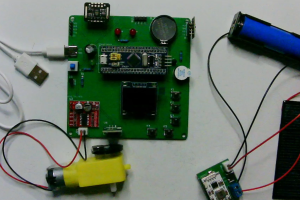设计说明书
总字数:16000+
摘 要
近年来,随着电动自行车的使用变多,安全出行、环保出行越来越收到重视。传统的电动自行车的车速是通过手把进行调速,调速系统基于开环控制,安全性和舒适性都存在不足,为了有效提高出行的安全性,设计一款自行车辅助系统十分必要。本设计以STM32单片机作为主控芯片,通过MAX30102检测司机心率值,通过DS18B20检测行驶环境温度值,通过MX1508驱动直流电机驱动车轮,并通过霍尔传感器进行测速,从而计算获取骑行里程,通过两个按键分别控制左右转向灯,当按键按下时,对应方向灯闪烁,并蜂鸣器间断提醒,并通过OLED显示时间、温度、心率、车速及骑行里程。此外,还可以通过蓝牙可将所有数据上传到手机端。各模块相互配合,共同完成自行车辅助系统的设计。
关键词:自行车辅助系统;显示屏;单片机;传感器;报警
Abstract
In recent years, with the increasing use of electric bicycles, safe travel and environmentally friendly travel have received more and more attention. The speed of the traditional electric bicycle is regulated by the handlebar, and the speed regulation system is based on open loop control, which has shortcomings in safety and comfort. In order to effectively improve the safety of travel, it is necessary to design a bicycle assistance system.In this design, STM32 single chip microcomputer is used as the main control chip, MAX30102 is used to detect the driver’s heart rate, DS18B20 is used to detect the driving environment temperature, MX1508 is used to drive the DC motor to drive the wheels, and Hall sensor is used to measure the speed, so as to calculate and obtain the cycling mileage. Two keys are used to control the left and right turn signals respectively. When the key is pressed, the corresponding direction light flashes, and the buzzer intermittens the reminder, and the time, temperature, heart rate, speed and mileage are displayed through OLED. In addition, all data can be uploaded to the mobile phone via Bluetooth. The modules cooperate with each other to complete the design of the bicycle auxiliary system.
Key words: bicycle assistance system; Display screen; Single-chip computer; Sensor; Give an alarm
目 录
第1章 绪 论
1.1 发展背景和现实意义
1.2国内外发展现状
1.3 设计功能实现
第2章 系统设计分析
2.1 系统总体设计分析
2.2 元器件选择
2.2.1 单片机的选择
2.2.2 按键的选择
2.2.3显示模块方案选择
第3章 控制系统硬件设计
3.1 单片机最小系统
3.1.1 主控模块电路
3.1.2 晶振电路
3.1.3 复位电路
3.1.4 电源电路
3.1.5 下载电路
3.2 DS18B20温度检测模块电路
3.3霍尔传感器模块设计
3.4 心率血氧检测电路模块
3.5独立按键模块电路
3.6 蜂鸣器报警提醒电路模块
3.7 显示模块电路
3.8充放电模块电路设计
3.9直流电机驱动模块
3.10 LED指示灯模块电路
3.11蓝牙模块(ECB02)
第4章 系统程序设计
4.1 编程软件介绍
4.2 系统主流程设计
4.3 独立按键
4.4 温度检测模块子流程
4.5 OLED显示流程设计
4.6 蓝牙模块子流程
第5章 实物测试
5.1 实物焊接
5.2 实物总体设计
5.3相关参数监测实物测试
5.4指示灯提醒实物测试
5.5蓝牙模块实物测试
总 结
参考文献
附 录
附录1:原理图
附录2:PCB
附录3:主程序
购买后可查看具体内容!

